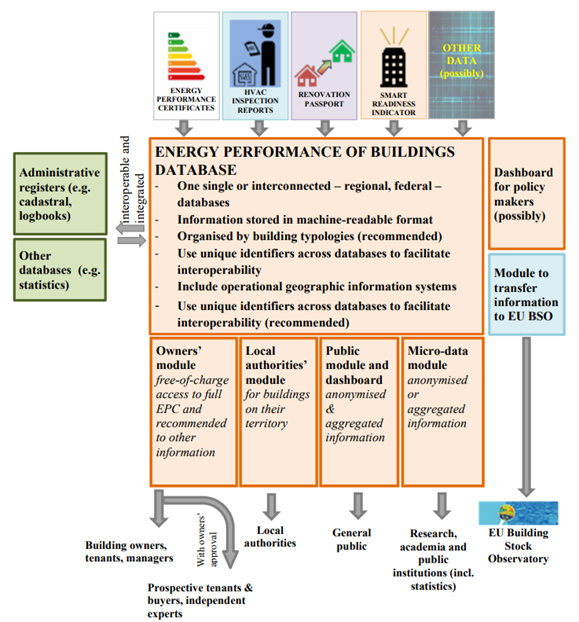
On 30 June 2025, the European Commission adopted a support package to help EU countries implementing and transposing the Energy Performance of Buildings Directive (“the recast EPBD”) into national law.
The Commission’s package comprises a delegated regulation, an implementing regulation, and a comprehensive set of guidance documents, offering practical support as EU Member States look to transpose the directive into national law by May 2026.
This blog dives into the details of:
The BSO implementing regulation sets out common templates for transferring information from the national databases for the energy performance of buildings to the EU BSO. The implementing regulation sets forth various information classifications (mandatory, mandatory if available, mandatory if applicable, and voluntary), the timeline and the procedure to transfer the information, as well as the scope and aggregation level of the information to be transferred.
The implementing regulation includes two annexes: Annex I, which comprises 23 tables with the set of data points to be transferred to the BSO; and Annex II, which establishes the formulas for totals and averages for the calculation of the relevant data points.
Amongst others, with regards the residential building stock, Member States will have to report the total number of energy performance certificates (EPCs) issued in the reported year, the share of buildings in the national building stock covered by EPCs, and the methodology followed for the energy use metrics included in the EPCs, namely, whether the EPC energy use is based on calculated energy, metered energy or on a mix of calculated and metered energy.
The document adopts the form of a Commission Notice, providing guidance and recommendations on Articles 17 and 18 of the recast EPBD.
With regard to Article 17, the Commission Notice provides guidance on:
“As part of their national energy and climate strategies, and in the framework of their national hub on energy efficiency financing as part of the European Energy Efficiency Financing Coalition, Member States could consider discussing potential trajectories that would allow national credit institutions to progressively allocate a higher share of their turnover to mortgages and non-collateralised loans targeting the energy renovation of worstperforming buildings.”
As such, the Commission encourages Member States to refer to the Notice not only when transposing the recast EPBD but also when preparing their national building renovation plans.
In terms of Article 18, the Commission Notice provides guidance on:
“The one-stop shop facilities are one of the main elements of the enabling framework to effectively encourage and support renovations. They are expected to become an integral part of the development and delivery of national building renovation plans.”
The document adopts the form of a Commission Notice, providing clarifications and practical recommendations on how to implement and make operational most of the requirements regarding EPCs which have been substantially updated or added in the recast EPBD, Articles 19-21 and Annexes V and VI.
Amongst other things, the Commission Notice highlights that the energy performance of the building must be expressed in the EPC as a number indicating primary energy use in kWh/(m2 .y), while the energy performance class must be expressed as a letter from a closed scale from A to G. The energy performance of the building must be determined in accordance with Annex I, to be consistent with the use of energy performance as the key metric and indicator in other provisions in the recast EPBD. The reference to closed scales means that each class should be defined by an upper and lower value and be clearly distinguished from the adjacent classes.
The Commission Notice also elaborates on the definitions of the various energy performance classes, as well as on the requirements that the EPC file needs to meet, e.g., machine readability (Article 19(4)). The Commission Notice makes reference to Directive (EU) 2019/1024 to define this concept, determining that EPCs will have to be in a format which allows software applications to easily identify, recognise, and extract specific data from it, for instance CSV, JSON or XML formats.
The document adopts the form of a Commission Notice, providing guidance on the structure of the databases, the data exchange with public and private stakeholders, and the data transfer with the EU BSO.
The Commission Notice recommends the setup of one integrated national energy performance database instead of a collection of interconnected regional/federal databases. Nevertheless, in cases where a set of databases is the chosen solution, the databases should be integrated, to the greatest extent possible, into a single public interface at the national level. To facilitate this integration, a consistent, logical, and coordinated format for data processing and storage is recommended. This methodology will enable the interoperability and integration of the database with other administrative databases containing information on buildings, such as the land register and digital building logbooks.
To achieve a robust dataset with greater reliability, the Commission Notice recommends harmonising the methodologies used for calculating and aggregating building data and other related information across the administrative databases, to make them compatible and avoid potential misalignments that may limit the data usage possibilities.

Figure 1: Possible architecture of an energy performance of buildings database. Source: Commission Notice on the Guidance on databases for the energy performance of buildings
The Commission Notice provides that the information made available through the national energy performance databases should be anonymised building-level data. However, it also foresees that some users will have access to more detailed data, which may include personal data. In this regard, the Notice suggests that Member States introduce a tiered-access approach, based on registration.
The Commission Notice includes the list of national databases identified by the Joint Research Centre in a report from 2023[1]. The report provides detailed information about the national systems, including national EPC registers and their main websites.
The document adopts the form of a Commission Notice, providing guidance on how Member States should ensure direct access to building systems’ data by interested parties.
The Commission Notice underscores the need that certain eligible parties should be given access to national energy performance databases based on their legitimate interest. While the term “eligible parties” is not further defined in the recast EPBD text, the Notice clarifies that this should be understood as bodies, i.e., public bodies, private companies, or other organisations that can have a legitimate interest in accessing building data. As an example, financial institutions are acknowledged to have a legitimate interest in accessing data on buildings in their investment and lending portfolios.
The ENGAGE Consortium welcomes the European Commission’s support package, which will contribute to the improvement of the availability of sustainability data required to advance the green transition.
For more information on how the ENGAGE Templates can help financial institutions structure and report ESG disclosures in line with the EU Taxonomy requirements, contact us at engage4esg@eurodw.eu.
To learn more about the European Commission’s support package, please click the button below.
To achieve the proposed 55% emission reduction climate target by 2030, around EUR 275 billion of additional investments are needed per year.
© Copyright 2022-23 Engage. All Rights Reserved.